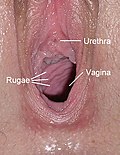Human vaginal size
Human vaginal size refers to the length and width of the human vagina. The size of the vagina varies among women, and it can change in certain situations, such as during sexual arousal and childbirth.
Anatomy[edit]
The vagina is a flexible tube that connects the external vulva to the cervix, the lower part of the uterus. It is located in the pelvic cavity behind the urinary bladder and in front of the rectum. The vagina is composed of a mucous membrane, muscle, and fibrous tissue.
Size[edit]
The size of the vagina can vary widely among individuals. In general, the length of the vagina is about 7.5 cm to 10 cm, and its width is typically between 1 cm and 2.5 cm. However, the vagina is a highly elastic structure and can stretch to accommodate a penis during sexual intercourse or a baby during childbirth.
Factors affecting vaginal size[edit]
Several factors can affect the size of the vagina, including:
- Age: The vagina can become less elastic and narrower with age, especially after menopause.
- Childbirth: The vagina can stretch significantly during childbirth to allow the baby to pass through. After childbirth, the vagina usually returns to its pre-pregnancy size, but it may remain slightly larger than before.
- Sexual arousal: During sexual arousal, the vagina lengthens and widens to prepare for sexual intercourse.
- Hormonal changes: Hormonal changes during the menstrual cycle can affect the size of the vagina.
Measurement[edit]
The size of the vagina can be measured using various methods, including:
- Vaginal photoplethysmography: This method uses a device that measures changes in blood flow to the vagina, which can indicate changes in vaginal size.
- Magnetic resonance imaging (MRI): MRI can provide detailed images of the vagina and can be used to measure its size.
- Physical examination: A healthcare provider can estimate the size of the vagina during a physical examination.
See also[edit]
Ad. Transform your life with W8MD's Budget GLP-1 injections from $75


W8MD offers a medical weight loss program to lose weight in Philadelphia. Our physician-supervised medical weight loss provides:
- Weight loss injections in NYC (generic and brand names):
- Zepbound / Mounjaro, Wegovy / Ozempic, Saxenda
- Most insurances accepted or discounted self-pay rates. We will obtain insurance prior authorizations if needed.
- Generic GLP1 weight loss injections from $75 for the starting dose.
- Also offer prescription weight loss medications including Phentermine, Qsymia, Diethylpropion, Contrave etc.
NYC weight loss doctor appointmentsNYC weight loss doctor appointments
Start your NYC weight loss journey today at our NYC medical weight loss and Philadelphia medical weight loss clinics.
- Call 718-946-5500 to lose weight in NYC or for medical weight loss in Philadelphia 215-676-2334.
- Tags:NYC medical weight loss, Philadelphia lose weight Zepbound NYC, Budget GLP1 weight loss injections, Wegovy Philadelphia, Wegovy NYC, Philadelphia medical weight loss, Brookly weight loss and Wegovy NYC
|
WikiMD's Wellness Encyclopedia |
| Let Food Be Thy Medicine Medicine Thy Food - Hippocrates |
Medical Disclaimer: WikiMD is not a substitute for professional medical advice. The information on WikiMD is provided as an information resource only, may be incorrect, outdated or misleading, and is not to be used or relied on for any diagnostic or treatment purposes. Please consult your health care provider before making any healthcare decisions or for guidance about a specific medical condition. WikiMD expressly disclaims responsibility, and shall have no liability, for any damages, loss, injury, or liability whatsoever suffered as a result of your reliance on the information contained in this site. By visiting this site you agree to the foregoing terms and conditions, which may from time to time be changed or supplemented by WikiMD. If you do not agree to the foregoing terms and conditions, you should not enter or use this site. See full disclaimer.
Credits:Most images are courtesy of Wikimedia commons, and templates, categories Wikipedia, licensed under CC BY SA or similar.
Translate this page: - East Asian
中文,
日本,
한국어,
South Asian
हिन्दी,
தமிழ்,
తెలుగు,
Urdu,
ಕನ್ನಡ,
Southeast Asian
Indonesian,
Vietnamese,
Thai,
မြန်မာဘာသာ,
বাংলা
European
español,
Deutsch,
français,
Greek,
português do Brasil,
polski,
română,
русский,
Nederlands,
norsk,
svenska,
suomi,
Italian
Middle Eastern & African
عربى,
Turkish,
Persian,
Hebrew,
Afrikaans,
isiZulu,
Kiswahili,
Other
Bulgarian,
Hungarian,
Czech,
Swedish,
മലയാളം,
मराठी,
ਪੰਜਾਬੀ,
ગુજરાતી,
Portuguese,
Ukrainian




